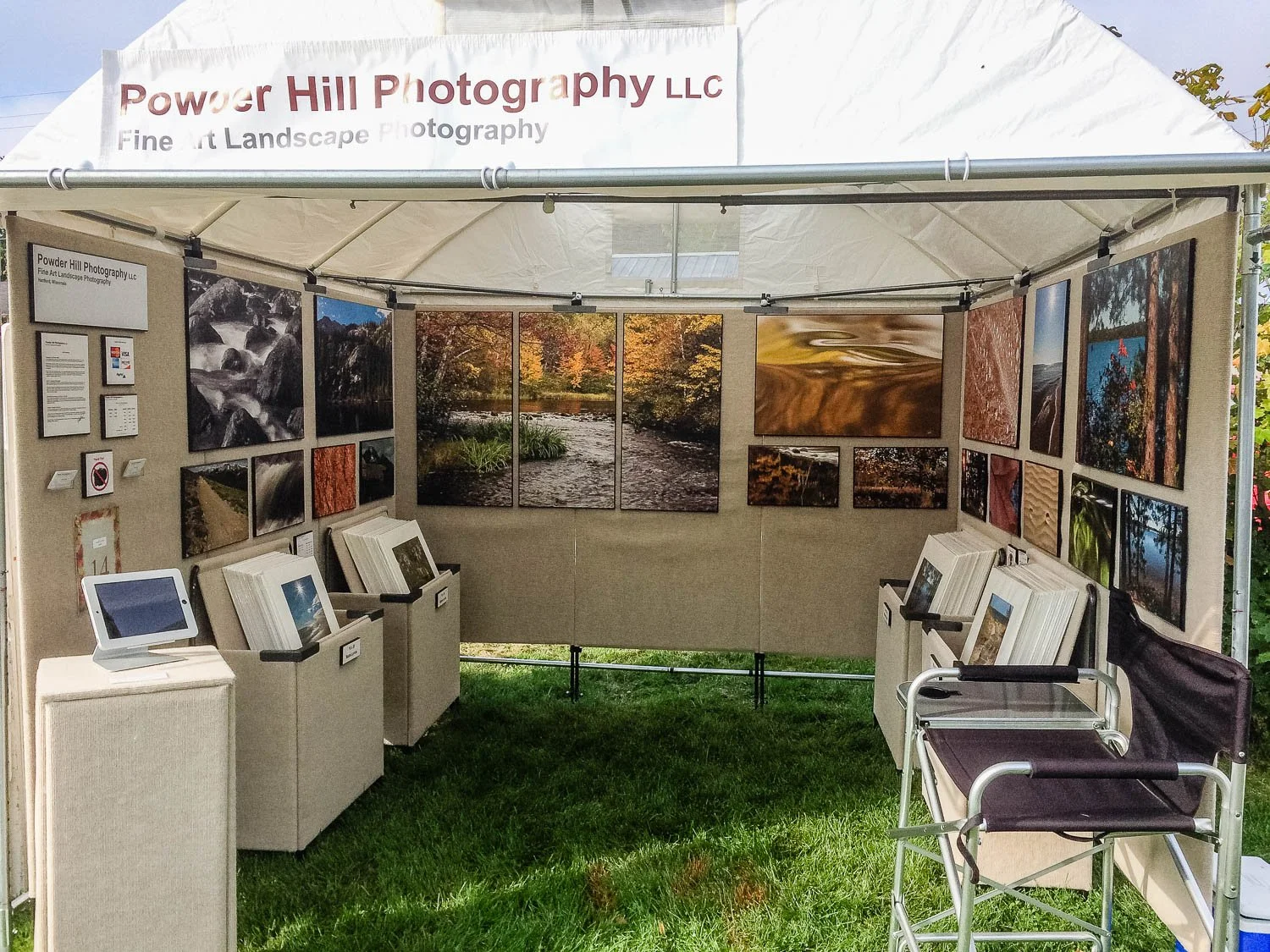The Customer’s Perspective
From The Eyes Of The Customer
Perhaps the easiest way to look at any product, presentation or demonstration is not from the provider’s eye, but rather from that of the customer. If you are the person who put together an elaborate presentation, it’s easy to miss its complexity.
I believe the same is true with the visual presentation of one’s prints at an art fair or other similar venue. Have you ever stepped into a booth and felt over-whelmed by the shear number of prints displayed, or the manner in which they were displayed?
I’ve seen outdoor booths with panels laid out in “cubby hole” fashion within the booth space. Others are more open and appear to be more spacious. Which might feel more appealing to the visitor? (Looking back, my first outdoor show layout in May 2012 was far from inviting!)
Specifically at art fairs, we each — for a period of the show — “own” a 10 foot x 10 foot area. To use this space effectively, a little pre-planning is required.
The layout and display of our product will be dictated somewhat by the product as well our personal vision. This is where “thinking like a consumer” will help guide you.
For One Day (At Least) We Aren’t Artists
It is true, we are the artist displaying our prints. But that isn’t primarily who we are on the day of the art show.
For the period of time our display is open, we are primarily in the retail sales business. We therefore, need to think in terms of the retail consumer.
Larger retail companies spend a great deal of money trying to understand their customers’ purchasing and shopping habits. Details are captured in these studies.
Where does the person look when they first enter a store? Does the location of signage matter? What difference does it make how the aisles are aligned? How does the lighting effect sales?
Fortunately the internet is filled with white papers and blog postings from these research companies. Google “consumer retail experience” and enjoy the reading material that will unfold before you.
Design Phase
When I first started my outdoor booth layout design (adopting the “U” shape layout), I drew to scale each of the three walls that would hold prints.
Before drawing in the prints (again to scale) I penciled in the placement of the bins and chair. This was an important first step which determined how low I would display the prints without having a bin or chair blocking its view.
Drawing the prints to scale gave me three “wall views” to evaluate. An overhead floor plan view provided the visual of determining the “walk-around” space within the booth.
Visually Attractive?
Once I was satisfied with the print layout, I then printed the same three pages with the exact images I planned to display as prints. Lightroom works great for this. I still do this phase each year when I change my booth display prints.
This “final print placement” page gets laminated and becomes my “cheat sheet” when setting up my booth at fairs. Without it, I’d forget where some of prints were to go!
With the images printed in the “wall view”, I could now decide if the prints look visually attractive together.
Think Like a Consumer
It’s at this stage that I really start trying to think like a consumer with regards to my booth display. The benefit of doing this “paper display” is that I can evaluate my booth without ever spending any time setting it up. I can also design my future booth display (when budget is available), and design back to what I have available at the time.
Personally, I look at each wall, including the placement of the signage and print bins, from what I think is the “consumers point of view”.
How do they enter my booth?
Given that one can walk past my booth from either direction, what is the first item they’ll see?
What if they look straight back into the booth?
Which print might catch the person’s immediate attention?
Do the prints (both layout and colors) complement each other, helping the viewer enjoy the prints?
Or do the prints cause “viewer conflict”, and thus create a less enjoyable experience?
Does the viewer have space to feel like they can enter the booth without interrupting another viewer?
Are they able to move around the booth, and still admire the prints?.
Game Day Evaluation
Art shows are a great place to test your assumptions.
Observe the viewers interactions with your prints. Perform your own on-site research.
When they enter your booth, ask which print drew them in.
How do they interact with your prints? Do they stand back, admire the larger prints, then look at the matted prints in the print bins? Are your bins comfortably spaced to hold a number of people within your 10×10 square?
Take Notes
You may not be able to make changes on that day or during the art show season.
But comes the off-season, you’ll again be evaluating your display and your notes and booth photos of each set-up will be most appreciated.
Most importantly, remember to “think like a consumer”.
My booth is now pretty much as shown above, after I have added the Pro Panels and Dura Plaq prints. As I tell people who ask, my booth layout has been a work-in-progress for a number of years - and it still is!
